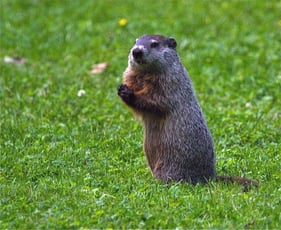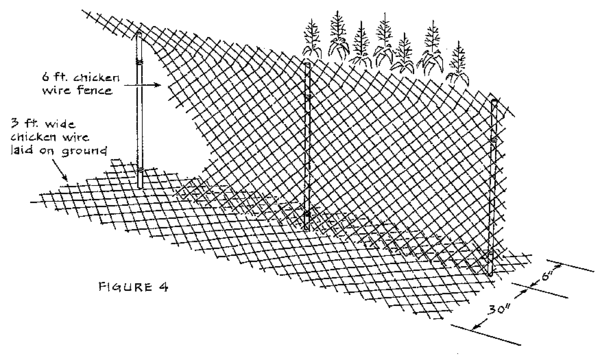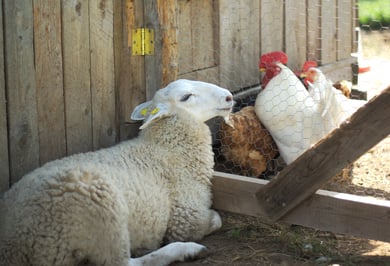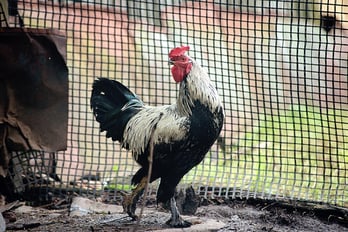
Your Garden at Peril
Battling a burrowing woodchuck can be a relentless task. Here are some of our answers to warding off this muncher and destroyer of your prized plantings.
Keeping a Woodchuck from Burrowing and Climbing
The clever woodchuck moves below ground as well as above.
- A 6-foot fence is required as a minimum, with 5-foot posts
- Chicken wire should be dug in 10 inches or more below ground level
- Leave a foot of chicken wire unattached from the post at the top and bend it outwards; this prevents the woodchuck from getting a good grip for climbing over the fence
Another possibility is:
- Place 3 feet of chicken wire flat on the ground around the perimeter of the garden
- After which, secure a 4 to 6-foot fence vertically 6 inches in from the chicken wire edge which will leave 2½ feet of chicken wire on the outside on the ground
- At the top, leave 12 inches of the chicken wire bent outwards away from the garden, unsecured
- The woodchuck will not be able to dig under the vertical fence because of the 3 feet of chicken wire surrounding the garden
As the updated Old Farmer's Almanac advises: The best woodchuck deterrent is a fence.
Image from Mass Audubon Society.org
A Very Broad Diet
A woodchuck is decidedly vegetarian, and your garden falls prey to them as they gorge during spring and summer-- fattening up for their long winter in the burrow. Vegetables are prized, as well as a vegetables' early tender shoots. Stems, roots, and bark are munched as well. Here is a fairly thorough list of a woodchuck's possible victims:
While wild grasses are a mainstay, woodchucks eat a variety of vegetation and agricultural crops including peas, beans, lettuce, zucchini, squash, pumpkin vines, green beans, broccoli, soybeans, parsnip leaves, onion stems, cilantro, dill, parsley, sage, alfalfa, eggplant, as well as clover, tree bark, and insects. Flowers at threat can include phlox, salvias, lupines, hollyhocks, rudbeckia, echinacea, poppies, astilbe, sedum, hostas, columbine, and the young, soft shoots of roses and delphiniums (though they are poisonous). Also dahlias, petunias, daisies, asters, cosmos, marigolds, nasturtiums, pansies, portulaca, tulips, sunflowers, and zinnias. Well, that does it for my garden!
Woodchuck Nation
Woodchucks are generously distributed in North America and Canada, extending to Alaska and in the south to Georgia. The clearing of forests has enabled the woodchuck to thrive. In open land and often near woods, a woodchuck's burrow is a small maze built of necessity. Entrances lead to tunnels which lead to chambers that are used for sleeping, rearing young, and even a separate chamber for burying waste. A variety of entrances provide hasty retreats when predators such as dogs and foxes appear and some holes may only be two feet deep for taking cover at such times. Burrow openings measure 8 to 12 inches, with additional holes at least 10 feet away. Not only do they eat crops, but trample them as well. Their holes can damage livestock. It is essential that we employ an appropriate arsenal to give these damaging rodents the heave-ho.
One man's battle, his fascination, and final answer--
Punxsutawney Phil
And finally, the celebration each February--the questionable observance of Groundhog Day--the honoring of one of our most destructive critters--the beloved Punxsutawney Phil who reigns as the predictor of the length of winter. Despite this fame, gardeners cast a wary eye to mounds and holes as this ravenous marauder tunnels, then nibbles and chomps through labored-over crops. Yes, it could be the single bite out of that prized tomato or the tragic beheading of a carrot that swiftly moves one to take up arms. Before we become violent, let's use some of the above-mentioned preventative measures. Ideally, a fence should be in place before a woodchuck is able to enter and start sampling produce.
At Louis Page, we are committed to providing you with the information and products that can protect your property and alleviate some of your stress. If you have questions, please get in touch, call us at (866) 328-5018.



















